8+ Sample Letter of Intent Contracts
-
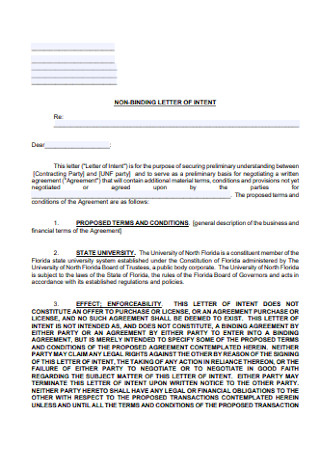
Non-Binding Contract Letter of Intent
download now -
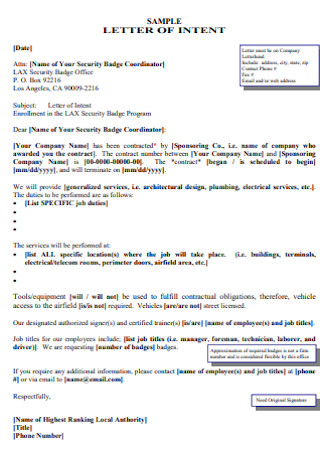
Sample Letter of Intent Contract
download now -
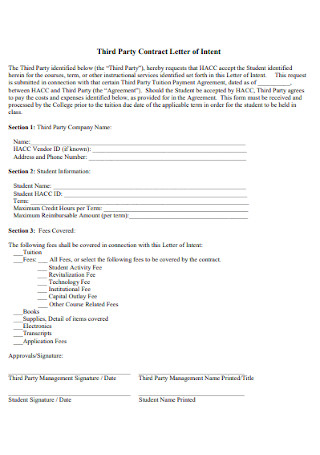
Third Party Contract Letter of Intent
download now -
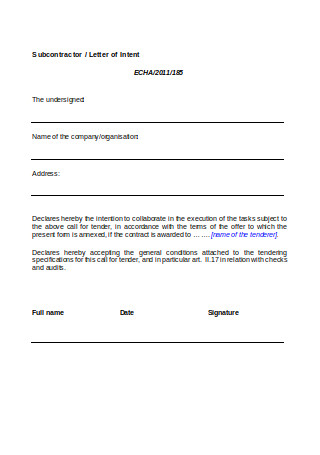
Subcontract Letter of Intent
download now -
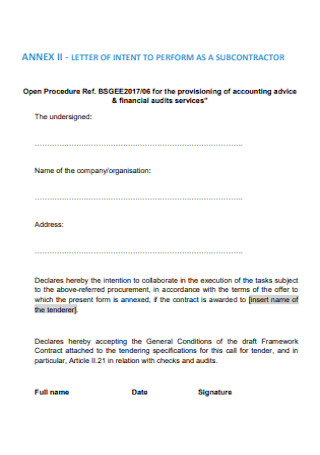
Letter of Intent to Perform Subcontractor
download now -
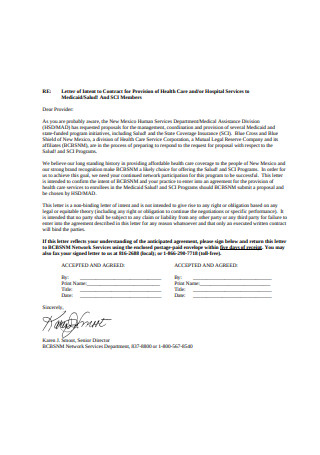
Simple Contract Letter of Intent
download now -
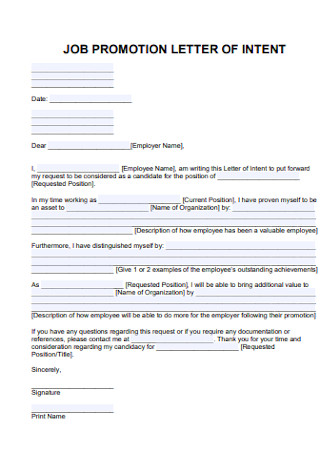
Job Contract Letter of Intent
download now -
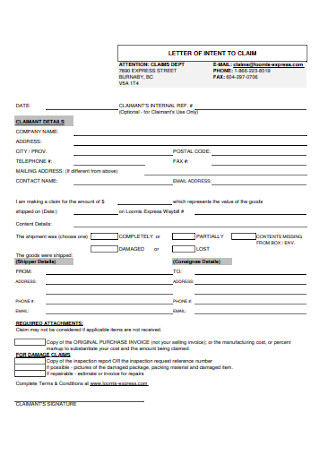
Letter of Intent for Claim
download now
FREE Letter of Intent Contract s to Download
8+ Sample Letter of Intent Contracts
What Is a Letter of Intent Contract?
When Is Letter of Intent Used?
What Is the Difference Between a Letter of Intent from a Cover Letter?
What to Include in a Letter of Intent?
Types of Letter of Intent
How to Write a Letter of Intent
FAQs
What Is the Importance of Using a Letter of Intent?
How Are Letter of Intent Used in Business?
Do Letters of Intent Expire?
What Is a Letter of Intent Contract?
Generally speaking, a letter of intent serves as an introduction to potential employers with who you are interested in working. You would typically submit a letter of intent to hiring managers or recruiters at a company that has not yet posted any positions that are relevant to your experience and qualifications. Even though it is comparable to a cover letter, a letter of intent contains less detailed information about a certain job. Instead, a letter of intent is intended to indicate your interest in working for a particular organization, as well as the reasons for your interest and the talents and experiences you possess that the employer may find helpful. It is a document that states one party’s intention to do something (for example, apply for a job, begin a request, or do business) in relation to another person or corporation, among other things.
It demonstrates your understanding of the deal and how to carry it out while also being respectful in your expression of interest. Furthermore, it allows you to receive a response or a request for a formal meeting/audience or authorization from the other party, which will kick off the preliminary agreement process. Any arrangement, whether personal or business in nature, is typically beginning by expressing interest, and a letter of intent is the formal means of doing so. Other templates are available on our website, and you can use them whenever you need them. They are as follows: employment contract, work contract, labor contract, letter of intent construction, letter of intent business form, letter of intent for proposal, nursing letter of intent, letter of intent loan, work agreement, permanent employment contract, and other similar templates are available. This post will not only provide you with templates but will also provide you with important information that you need to know in order to complete your template.
When Is Letter of Intent Used?
A letter of intent can be used in a number of different situations. There are a variety of situations in which it is used, including when applying for employment, requesting to be admitted to a school or university, applying for a scholarship, asking for business documents or permits, applying for promotion, asking for financing, and expressing a desire to purchase a business or real estate.
In a typical business setting, it is used to layout the fundamentals and main aspects of a prospective transaction before a formal legal agreement is entered into. Individuals frequently utilize a letter of intent (LOI) to indicate interest in or to request approval for employment, documentation, permits, clearance, and/or other connected matters, among other things.
What Is the Difference Between a Letter of Intent from a Cover Letter?
While you may submit a cover letter when applying for a position that has been advertised, a letter of intent is preferable when you want to demonstrate to an employer that you are interested in working for them even if there are no current job openings available. A letter of intent can be written at any moment and may or may not result in a clear next step, but a cover letter is more likely to result in an interview and a job offer, depending on the situation.
What to Include in a Letter of Intent?
However, while your letter of intent should be personalized to reflect your unique mix of abilities, experiences, and traits, there are five essential components that you should include in your letter. Consider these five elements in greater detail, as well as the information that should be included in each of them.
1. A Friendly Greeting or Salutation
The greeting or salutation should be professional in tone and format, and it should adhere to formal greeting forms. If you want to address the letter to a specific employee within the firm, you can use a typical greeting such as “Dear Hiring Manager.” While you may be able to locate HR staff to send your letter to, if you’re unsure, a more general greeting such as “Hello” would suffice. Nonetheless, avoid using a welcome that is too familiar or informal (“Hey,” for example, or addressing the recipient by his or her first name). In order to make a good first impression, the letter of intent should be positive and professional. This initial impression may lead to future employment prospects.
2. The First Paragraph of the Introduction
Introduce yourself in the first one or two phrases of your letter by providing a formal introduction. This section should include your name, a brief explanation of your current degree of experience, and the reason for your sending the letter. If you are a recent graduate, for example, you should include information about your degree and areas of study in your resume. For those of you who are presently working and seeking employment with another organization, please provide your job title and a brief explanation of why you are interested in the company to which you are writing. It’s preferable if you can avoid including any negative material in your correspondence. Perhaps you don’t want to disclose that you’re thinking about moving employers since you’ve had a poor experience with your current company. Replace this with a brief explanation of why you are interested in the organization or any other good reasons, such as opportunities for promotion or the ability to explore a different role.
3. The Physical Structure
To expound on your qualifications and experiences, write the body of your letter. This is an excellent time to elaborate on why you would be a beneficial addition to the organization in one or two paragraphs if you like. Specific instances of times you achieved a goal or made a significant contribution to the success of an organization should be included, and your accomplishments should be quantified wherever possible. When expressing interest in a potential job, you should make a point of emphasizing how your abilities and experiences connect with the firm’s vision and requirements.
4. A Call-to-Action Should be Included
This is the closing paragraph of your letter, and it is where you explain what you would like the employer to do as a result of your letter’s contents. Example: You might use this section to thank the company for reading your letter and for getting in touch with you about possible job openings in the future. Instead of including your contact information after your signature, you might include it in this section instead.
5. Concluding Remarks
In the final paragraph, use a normal business letter sign-off to conclude. For example, you may just close with “Sincerely,” “Thank you,” or another such phrase. As with the opening, it’s best to avoid being too casual here, so refrain from using sign-offs such as “Cheers” or “Yours truly” at the end of your letter.
Types of Letter of Intent
A letter of intent can be used in a variety of situations. Here are some of the most common types of Letters of Intent (LOI) and their applications.
How to Write a Letter of Intent
In this section, you’ve studied what a Letter of Intent is, how it’s used, and when it’s appropriate to use it (and how to format them for each scenario). In this section, we’ll take a more broad approach to demonstrate how each section of an LOI should be written, as well as provide you with a couple of writing pointers to make the process more successful and less difficult. Before you do anything else, keep in mind that your goal is to be as clear as possible while remaining concise. Your ultimate goal is to compose an interesting letter that emphasizes how you or your prospective project/venture may provide value to the other party’s situation.
Step 1: Proper Salutation
When possible, utilize the actual names of the people who will be receiving the letter. Research is your best friend in this situation, and you should start with the company’s website. If it is not possible, you can always use a more generic salutation such as “To whoever it may concern” or “Dear Sir or Madam.”
Step 2: Solid Opening of Paragraph
It enables the reader to comprehend the purpose of the message in a short amount of time. When you write a brief summary stating why you’re writing, the reader will have enough background to understand and appreciate the rest of the letter. Depending on the nature of your request, the opening statement should include one or more of the following statements: What you’re requesting, how much financing or budget you require, and what you’re proposing are all important considerations.
Step 3: Main Body
Your abilities and expertise should be highlighted in this section, and you should present them in a way that is relevant to the nature of your request. For example, if you’re writing a letter of intent to apply for a position, you should include your relevant abilities and experience and explain how they would benefit the organization. For a business proposal, including facts and numbers from previous accomplishments, as well as a discussion of why and how your idea will benefit the other party in question. Because it serves as the stage for “selling” what you have to give, this section of the letter is possibly the most significant of the entire document.
Step 4: Call to Action
The next step is to clearly state what your receiver should do next in the form of a call-to-action button. Normally, you include your contact information (email address, phone number, and other pertinent information) so that they can readily contact you if necessary. After then, you inform them of their alternatives for replying to your letter.
Step 5: Closing Part
In your closing, express your appreciation for their time spent reading the letter using a formal phrase such as “Sincerely,” “Thank you,” or “Best Regards.”
In the event that there are no specific opportunities available in your field, submitting your CV to a company via a letter of intent makes it much easier. In this way, the employer will be able to show your value and interest in their company, which may motivate the employer to determine whether the organization has a need or job that you can fill.
FAQs
What Is the Importance of Using a Letter of Intent?
Letters of intent, in contrast to contracts and agreements, are nonbinding, allowing the parties to unilaterally change the terms of the agreement. The usage of a letter of intent is critical because it ensures that both parties are on the same page before fully committing to the terms of the agreement.
How Are Letter of Intent Used in Business?
Letters of intent in business are used to express the amount of money that the buyer will be required to pay the seller for the items that they have acquired. As an additional feature of this correspondence, it describes the courier’s physical state when he arrives to pick up the package. Finally, letters of intent serve as a legally binding document that proves that the transaction took place.
Do Letters of Intent Expire?
Yes, letters of intent can and do expire. The letter’s validity period is usually between 72 and 96 hours, but it might be longer or shorter. Alternatively, in rare situations, its validity can be extended to up to two weeks.
In the vast majority of situations, people proceed immediately to give over legally binding documents to establish terms. However, it is preferable, to begin with, a preliminary paper in order to provide the opposing party with a heads-up on the terms and circumstances of the agreement. Letters of intent are a type of preparatory document that is more commonly used. If you don’t know how to create a Letter of Intent from scratch, we offer various Letter of Intent Templates that you can use as a guide. They are professionally written samples with suggestive content that you are free to change to your liking. By subscribing to our templates today, you may establish terms without overwhelming the other party.
